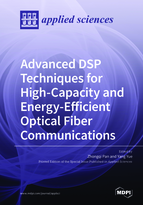Advanced DSP Techniques for High-Capacity and Energy-Efficient Optical Fiber Communications
A special issue of Applied Sciences (ISSN 2076-3417). This special issue belongs to the section "Optics and Lasers".
Deadline for manuscript submissions: closed (30 June 2019) | Viewed by 41476
Special Issue Editors
Interests: optical communications and networking; digital signal processing; optical sensing
Special Issues, Collections and Topics in MDPI journals
Interests: intelligent photonics; optical communications; optical perception; optical chip
Special Issues, Collections and Topics in MDPI journals
Special Issue Information
Dear Colleagues,
Network traffic has been increasing exponentially over decades. This enormous growth rate will continue, in the foreseeable future, due to many newly-emerging and unanticipated digital applications and services. To fulfill the ever-growing bandwidth demand, not only spectral efficiency of optical fiber communication system needs to be improved, but also power/wavelength needs to be reduced so that higher individual data rates per wavelength of up to multi-Tb/s can be achieved with total aggregate capacities beyond Pb/s. As one of the most prominent enable technologies, digital signal processing (DSP) has played a critical role in coherent system to accommodate channel impairments mitigation, to enable advanced modulation formats for spectral efficiency transmission, and to realize flexible bandwidth.
This Special Issue aims to explore the novel advanced DSP techniques to enable multi-Tb/s/channel optical transmission for addressing the pressing bandwidth and power-efficiency demands. It will focus on the state-of-the-art advances and future perspectives of DSP. Topics of interest include, but are not limited to, the following areas:
- DSP for mitigation/compensation of fiber channel and optical transceiver impairments.
- Digital fiber nonlinearity mitigation/compensation.
- DSP for multi-dimensional modulation and constellation shaping.
- MIMO signal processing for space-division multiplexing.
- DSP for direct detection and short-reach fiber systems.
- Power efficient DSP.
Prof. Zhongqi Pan
Dr. Yang Yue
Guest Editors
Manuscript Submission Information
Manuscripts should be submitted online at www.mdpi.com by registering and logging in to this website. Once you are registered, click here to go to the submission form. Manuscripts can be submitted until the deadline. All submissions that pass pre-check are peer-reviewed. Accepted papers will be published continuously in the journal (as soon as accepted) and will be listed together on the special issue website. Research articles, review articles as well as short communications are invited. For planned papers, a title and short abstract (about 100 words) can be sent to the Editorial Office for announcement on this website.
Submitted manuscripts should not have been published previously, nor be under consideration for publication elsewhere (except conference proceedings papers). All manuscripts are thoroughly refereed through a single-blind peer-review process. A guide for authors and other relevant information for submission of manuscripts is available on the Instructions for Authors page. Applied Sciences is an international peer-reviewed open access semimonthly journal published by MDPI.
Please visit the Instructions for Authors page before submitting a manuscript. The Article Processing Charge (APC) for publication in this open access journal is 2400 CHF (Swiss Francs). Submitted papers should be well formatted and use good English. Authors may use MDPI's English editing service prior to publication or during author revisions.
Keywords
- Digital signal processing
- Fiber communications
- Coherent optical transport
- MIMO signal processing
- Spatial division multiplexing
- Chromatic dispersion
- Polarization mode dispersion
- Fiber nonlinearities
- High-order modulations
- Constellation shaping
- Data center







